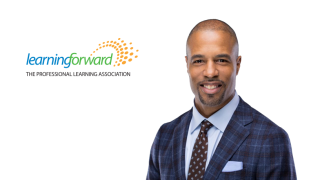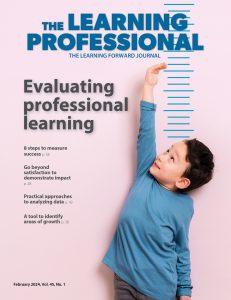Tina Christensen, a 7th grade English language arts teacher at Falcon Bluffs Middle School in Littleton, Colo., has been wanting to improve the way she structures mini-lessons for her students. So she pulls up the district professional learning dashboard on her computer and adds a new “professional goal.” Creating the goal offers Christensen a variety of resources, such as videos and articles, and captures the “action items” she chooses to improve her practice.
Giving teachers this flexibility to choose the resources that meet their needs has been a high priority for Jefferson County Public Schools in Colorado (JeffCo)—one of 20 school systems participating in the Redesign PD Community of Practice. But the team has also decided that it’s equally important to ensure that when teachers engage in professional learning that the experience meets specific standards of quality.
“How do we make sure we lift up and support our teachers, but also make sure that it is high quality?” explains Marna Messer, the assistant director of JeffCo’s Innovative Professional Development (iPD) initiative.
When the JeffCo team first looked at the wide variety of professional learning opportunities the district provides, they realized that there had probably been more emphasis on the quality of the offering and not enough on how teachers were implementing what they had learned and whether data was being used to determine the impact of the learning.
So the team had some honest conversations about how to shift away from just providing professional learning and move in the direction of making sure teachers receive ongoing support tied to that learning.
Becoming a ‘growth-oriented system’
As part of the Cycle of Inquiry that the Community of Practice districts use to address challenges and make progress, the JeffCo team first engaged a group of roughly 150 people at the central office level in studying the Standards for Professional Learning and discussing what JeffCo was doing to meet those standards.
“We weren’t always in the same place,” Messer says, adding that the next step involved developing some key elements to look for related to professional learning.
Because they initially received such diverse opinions from the larger group of 150 on how to measure professional learning, the team decided to scale back for the second cycle and test out those “look fors” with a smaller group. When the district holds its Launch, Learn and Lead summer institute in August, the smaller group of about 30 participants will apply those standards to the learning provided through the institute. The question, Messer says, is “how do we become a growth-oriented system and help our professional learning get better and better?”
The district’s work with the standards will also guide those educators working to make the professional learning tool as useful for teachers as possible.
“We’re really excited about the standards because it will bring common language and common expectations around professional learning to our district,” says Lisa Summitt, an instructional specialist with JeffCo. She adds that her team is especially focusing on one aspect of the Resources standard, which states: “Professional learning that increases educator effectiveness and results for all students requires prioritizing, monitoring, and coordinating resources for educator learning.”
“Since a good portion of our work on the professional learning module in the dashboard is finding and vetting excellent resources for teachers in order to constantly improve in the classroom,” she says, “we will use this standard to drive our work this coming year.”
Going forward, Messer says the challenge will be how to again spread understanding and ownership of the standards across schools. “If you go too big, you don’t get deep, you get compliance,” she says. “There’s not enough buy-in.”
Mary Beth Bazzanella, the director of educational technology for the district, calls the dashboard “a foundational tool that complements the entire teaching-learning cycle.” She adds that she’s encouraged by the attention cabinet-level officials in the district are giving to professional learning. “We’re pushing into the classroom,” she says, “but we’re also pushing up to the district level.”
Measuring Impact
Problem of Practice:
How do we measure the impact of professional learning experiences on teacher practice in formative and summative ways to inform teacher, school, and system decisions to drive continuous improvement?
JeffCo vision:
Teacher and school leaders will have access to high-quality professional learning information, which will lead them to make impactful professional learning choices aligned to school Unified Improvement Planning goals, teacher individual educator goals, and personal learning needs.
As part of the community, JeffCo has “become more intentional about data collection,” says Marna Messer, the assistant director of JeffCo’s iPD initiative. The qualitative and quantitative methods used include:
- Focus groups for Math Design Collaborative participants and “capacity builders” (teacher leaders);
- Feedback from mini-grant recipients; and
- A survey for all iPD participants.






